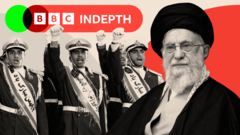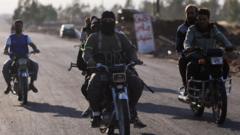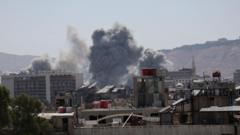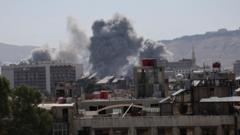The aftermath of recent military conflict has left Iran weakened, leading to rising dissatisfaction with Supreme Leader Khamenei, even as he grapples with political challenges and internal dissent following significant military losses.**
Iran's Supreme Leader Faces a Changed Landscape Amidst Ongoing Turmoil**

Iran's Supreme Leader Faces a Changed Landscape Amidst Ongoing Turmoil**
As Ayatollah Khamenei considers emerging from hiding, Iran confronts national devastation, dissent among elites, and a populace increasingly hostile towards the regime.**
In a time of profound uncertainty, Iran's Supreme Leader, Ayatollah Ali Khamenei, has remained hidden for nearly two weeks, fearing for his safety amidst an ongoing conflict with Israel. Reports suggest he is in a secret bunker, disconnected from government officials, following a harrowing wave of military strikes that have significantly degraded Iran's capabilities. With a fragile ceasefire brokered by U.S. President Donald Trump and Qatar's Emir in effect, there is speculation as to whether Khamenei will risk emerging to confront the destruction and dissent facing his nation.
Should he decide to make an appearance, Khamenei will encounter a stark reality: the war has not only diminished Iran's military infrastructure but has also led to public outcry and disappointment towards his leadership, with many blaming him for pursuing aggressive policies that have resulted in widespread poverty and isolation.
Debates about the future of Iran's leadership are intensifying. Some former members of the regime have reportedly called for intervention from influential religious scholars, hinting at a desire for leadership change. Pressure from both within Iran's ruling elite and from its citizens is palpable, with discontent simmering as frustrations grow over human rights violations and governmental failures.
Iranians have shown remarkable solidarity in the face of chaos, supporting one another amid fear for their safety and frustration towards the regime. Yet, many are wary of foreign-imposed regime changes, emphasizing the need for internal reform rather than external intervention.
Opposition within the country remains fragmented, as Khamenei has effectively quashed dissent over nearly four decades of rule. However, as the economic strain mounts and rumors of further government crackdowns circulate — including recent executions of perceived spies — the potential for a grassroots movement seems to be on the horizon.
While Khamenei grapples with his own declining health at the age of 86, he is tasked with considering his legacy and the future stability of his regime. Despite the immediate survival of his leadership, many experts speculate that this moment may signify the beginning of the end for Khamenei's reign, presenting critical questions about Iran's next chapter and the regime's grip on power.
Challenges loom large, and as the landscape shifts, only time will reveal whether Khamenei can navigate the storm and what direction Iran will ultimately take.





















